SEO
The #1 Factor That Will Help Your Content Rank in Google
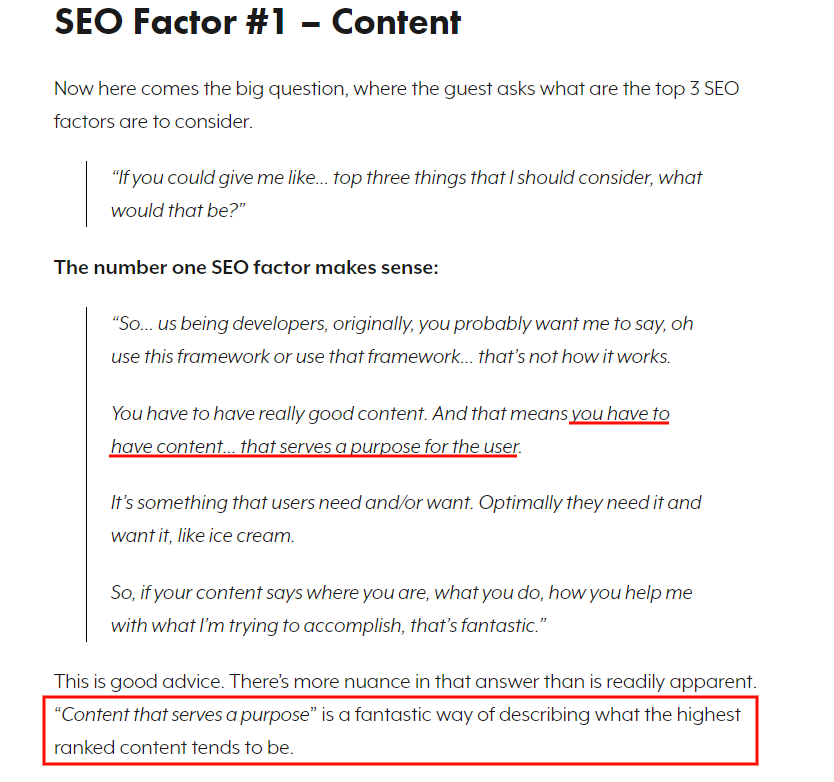
If one thing matters more than anything to Google, it’s your content’s relevance to the reader.
(Is it useful? Does it serve a purpose for them connected to their search intent?)
This fact came into focus once again in the first episode of Google’s YouTube series, SEO Myth Busters.
In particular, a Search Engine Journal post by Roger Montti outlines insights from this episode we can apply right now.
The #1 SEO factor mentioned: user-relevant content that serves a purpose.
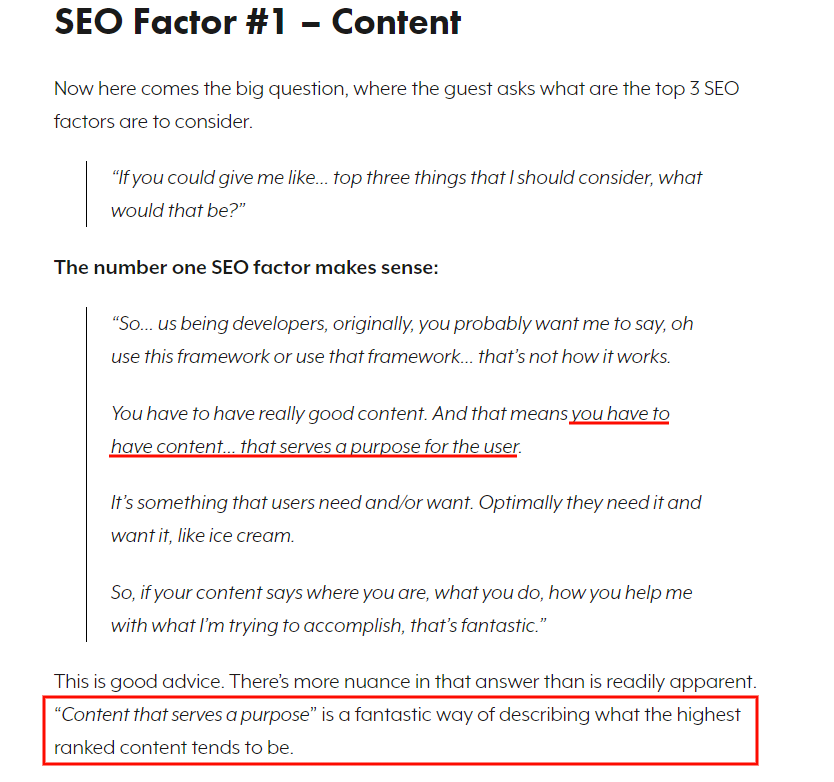

We see this sentiment about the importance of user relevance echoed in other Google sources, too, like the Webmaster Guidelines:


And the Search Quality Evaluator Guidelines (for example, pages without a beneficial purpose get the lowest page quality rating):


Needless to say, concepts like relevancy and beneficial purpose in your content are vital to ranking well.
The only question left is, how do you craft content that meets or exceeds these standards?
Let me answer that question by using one of my #1 ranking blog posts as an example.
Let’s break it down.
How to Infuse Your Content with Relevancy & Beneficial Purpose to Rank Well in Google
Here’s a good example of a blog post created with reader relevancy and beneficial purpose in mind, called “Learn to Write: The Ultimate Guide to Get You Started.”


To prove how well it’s working, take a look at the SERP for “learn to write” – the post is currently ranking in the #1 organic position.


How did I create this content with a purpose, and earn top rankings in Google?
By hyper-focusing on the reader, letting them inform every step of content creation.
First tip: Use the language your readers are using.
1. Speak to Your Reader (Use Their Language)
To create content that’s useful, that serves a purpose for the reader, you need to use the language they’re using.
This may seem simple, but it needs research backing it up to ensure you’re on the right track.
You can’t just guess at how your readers describe their problems, interests, and desires because you’ll probably guess wrong.
Instead, it’s important to do social listening, talk to actual customers, gather examples, and base the language you use in your content on what you discover.
We have a defined audience we speak to based on a persona we created – a fictional archetype of our ideal customer. This persona stems solely from audience research.
As you can see, our tone of voice and language are laid-back but professional, fun yet never sloppy, direct, engaging, and geared toward a younger, millennial audience.
We never would have pinpointed this tone without audience research!
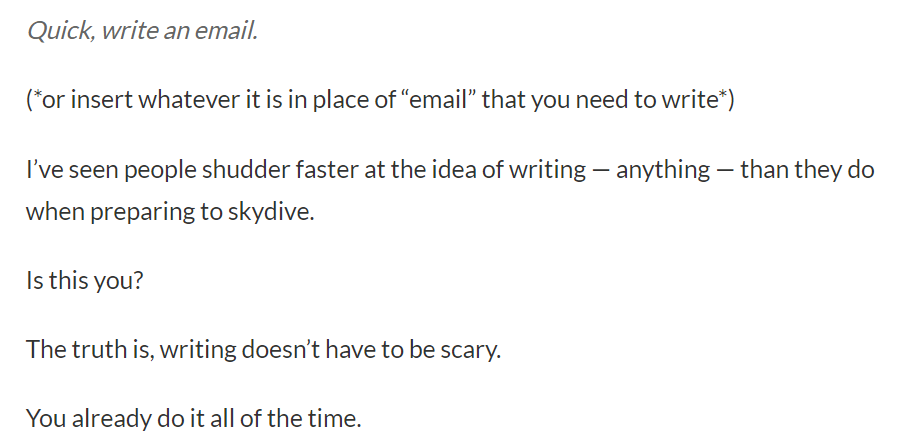

2. Speak to Your Readers’ Problems
Luckily, audience research does a lot more than tell you who you’re writing for. It also pinpoints your readers’ problems – especially the ones you (and only you, with your unique expertise) can solve, improve, or alleviate.
This is a big, big part of infusing your content with beneficial purpose and relevance.
The reader problem I address in our example blog is relatively straightforward: They may be afraid of writing, but they need to learn to do it better to achieve more in their day-to-day lives.
As an online writing expert with a content agency, I’m uniquely positioned to help them.
Note how I speak to Millennial-centered facets of this problem in our example.
For instance, most of our readers will be young professionals who need to use writing in at least one aspect of their job. I directly address this in the first section:
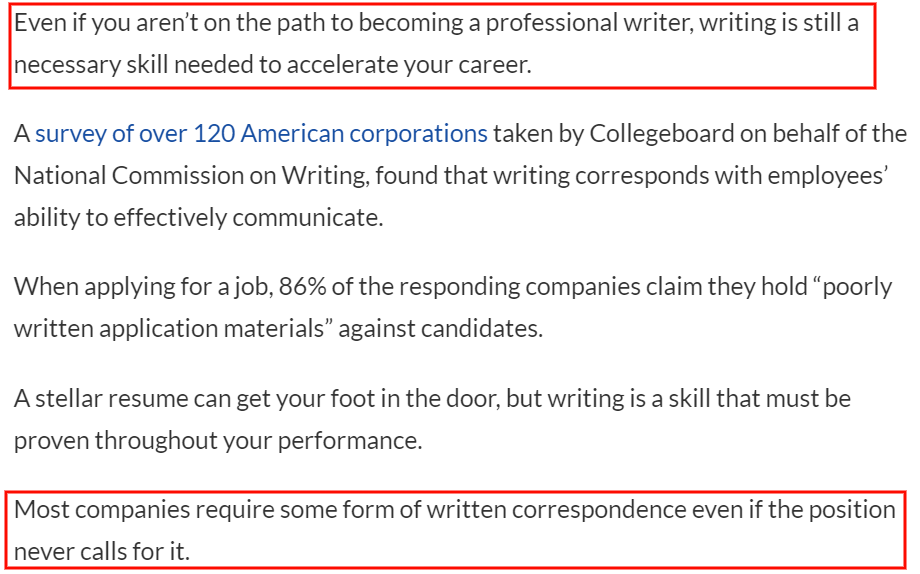

In particular, I’m reminding them why learning to write matters for them and their particular needs.
If you can answer the question “why should the reader care about this content?” inside the blog you’re writing, that’s a sign you’re on the right track to infusing your content with a purpose.
3. Use Keywords with Your Content’s Purpose & Reader Vocabulary in Mind
The purpose of your content is the problem you’re solving for the reader (and keep in mind that the problem can be as simple as making them laugh and lightening their day or as complex as teaching them how to code a website).
Your keywords should connect to that problem, as well as use the reader’s vocabulary.
- The problem you’re solving: You should be able to condense the reader problem you’re solving (“I need to learn to write more effectively”) into a simpler keyword phrase (e.g. “learn to write”).
- Audience questions: Audience questions will form the keywords you use, too. For example, your readers might be asking Google “how to write well,” “learn to write,” “professional writing,” or “writing for the web.”
- Related terms: If you scroll to the bottom of the SERP for your main keyword, you’ll find related terms users are actually searching as well.


Don’t forget to vet all the keywords you find. Research them with keyword tools and make sure they’re good fits for your brand to target (for instance, if the competition is too steep, small brands have a slim chance of ranking even if your content is amazing, user-relevant, and purposeful).
4. Avoid Industry Jargon & Insider-Speak
Repeat after me: The way you talk about your business/industry/products/services is not the way your customers talk about them.
Undecipherable jargon in your content can be its downfall. It’s like talking about an inside joke with a friend in a room full of strangers – totally awkward for everyone outside that “in-the-know” bubble.
You never want your readers to feel awkward, confused, belittled, or stupid.
That’s why, in our example blog post, we don’t talk about nitty-gritty grammar details like Oxford commas or em-dashes. We don’t go over their heads with spiels about modifiers and determiners.
We definitely don’t include nerdy, writers-only references. (We save those for our team discussions.)
Instead, the focus is on being relatable, relevant, and easy to understand.
When I make references, they’re to universally understood concepts, like salespeople and common sayings.
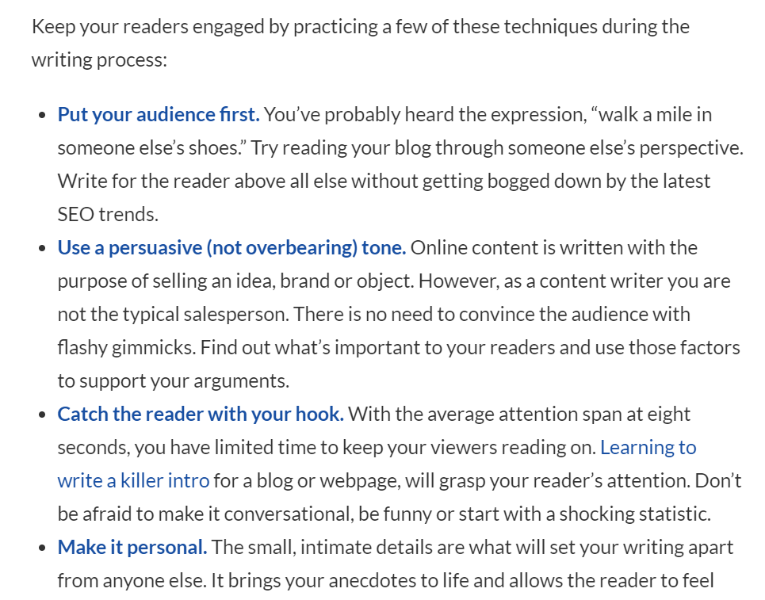

Insider-speak is for conversations with your work colleagues, not for talking to your audience. Instead, aim to have empathy and put yourself in your readers’ shoes.
Try to understand their problems from their point-of-view and provide the answers in ways they’ll connect with – your content will be better for it.
Crafting User-Focused Content: Make It Priority #1 to Be #1
Content isn’t about you, your brand, or your business.
It’s about the user.
Added to that, Google loves content that serves a beneficial purpose for the user. If it doesn’t help the target reader in a quantifiable way, if it doesn’t answer the question they were asking in the Google search bar, it’s no good.
To make your content shoot to the top of the SERPs, you need to make it useful, purposeful, and relevant. Follow these tips, and you’ll be well on your way.
SEO
brightonSEO Live Blog

Hello everyone. It’s April again, so I’m back in Brighton for another two days of Being the introvert I am, my idea of fun isn’t hanging around our booth all day explaining we’ve run out of t-shirts (seriously, you need to be fast if you want swag!). So I decided to do something useful and live-blog the event instead.
Follow below for talk takeaways and (very) mildly humorous commentary. sun, sea, and SEO!
SEO
Google Further Postpones Third-Party Cookie Deprecation In Chrome

Google has again delayed its plan to phase out third-party cookies in the Chrome web browser. The latest postponement comes after ongoing challenges in reconciling feedback from industry stakeholders and regulators.
The announcement was made in Google and the UK’s Competition and Markets Authority (CMA) joint quarterly report on the Privacy Sandbox initiative, scheduled for release on April 26.
Chrome’s Third-Party Cookie Phaseout Pushed To 2025
Google states it “will not complete third-party cookie deprecation during the second half of Q4” this year as planned.
Instead, the tech giant aims to begin deprecating third-party cookies in Chrome “starting early next year,” assuming an agreement can be reached with the CMA and the UK’s Information Commissioner’s Office (ICO).
The statement reads:
“We recognize that there are ongoing challenges related to reconciling divergent feedback from the industry, regulators and developers, and will continue to engage closely with the entire ecosystem. It’s also critical that the CMA has sufficient time to review all evidence, including results from industry tests, which the CMA has asked market participants to provide by the end of June.”
Continued Engagement With Regulators
Google reiterated its commitment to “engaging closely with the CMA and ICO” throughout the process and hopes to conclude discussions this year.
This marks the third delay to Google’s plan to deprecate third-party cookies, initially aiming for a Q3 2023 phaseout before pushing it back to late 2024.
The postponements reflect the challenges in transitioning away from cross-site user tracking while balancing privacy and advertiser interests.
Transition Period & Impact
In January, Chrome began restricting third-party cookie access for 1% of users globally. This percentage was expected to gradually increase until 100% of users were covered by Q3 2024.
However, the latest delay gives websites and services more time to migrate away from third-party cookie dependencies through Google’s limited “deprecation trials” program.
The trials offer temporary cookie access extensions until December 27, 2024, for non-advertising use cases that can demonstrate direct user impact and functional breakage.
While easing the transition, the trials have strict eligibility rules. Advertising-related services are ineligible, and origins matching known ad-related domains are rejected.
Google states the program aims to address functional issues rather than relieve general data collection inconveniences.
Publisher & Advertiser Implications
The repeated delays highlight the potential disruption for digital publishers and advertisers relying on third-party cookie tracking.
Industry groups have raised concerns that restricting cross-site tracking could push websites toward more opaque privacy-invasive practices.
However, privacy advocates view the phaseout as crucial in preventing covert user profiling across the web.
With the latest postponement, all parties have more time to prepare for the eventual loss of third-party cookies and adopt Google’s proposed Privacy Sandbox APIs as replacements.
Featured Image: Novikov Aleksey/Shutterstock
SEO
How To Write ChatGPT Prompts To Get The Best Results

ChatGPT is a game changer in the field of SEO. This powerful language model can generate human-like content, making it an invaluable tool for SEO professionals.
However, the prompts you provide largely determine the quality of the output.
To unlock the full potential of ChatGPT and create content that resonates with your audience and search engines, writing effective prompts is crucial.
In this comprehensive guide, we’ll explore the art of writing prompts for ChatGPT, covering everything from basic techniques to advanced strategies for layering prompts and generating high-quality, SEO-friendly content.
Writing Prompts For ChatGPT
What Is A ChatGPT Prompt?
A ChatGPT prompt is an instruction or discussion topic a user provides for the ChatGPT AI model to respond to.
The prompt can be a question, statement, or any other stimulus to spark creativity, reflection, or engagement.
Users can use the prompt to generate ideas, share their thoughts, or start a conversation.
ChatGPT prompts are designed to be open-ended and can be customized based on the user’s preferences and interests.
How To Write Prompts For ChatGPT
Start by giving ChatGPT a writing prompt, such as, “Write a short story about a person who discovers they have a superpower.”
ChatGPT will then generate a response based on your prompt. Depending on the prompt’s complexity and the level of detail you requested, the answer may be a few sentences or several paragraphs long.
Use the ChatGPT-generated response as a starting point for your writing. You can take the ideas and concepts presented in the answer and expand upon them, adding your own unique spin to the story.
If you want to generate additional ideas, try asking ChatGPT follow-up questions related to your original prompt.
For example, you could ask, “What challenges might the person face in exploring their newfound superpower?” Or, “How might the person’s relationships with others be affected by their superpower?”
Remember that ChatGPT’s answers are generated by artificial intelligence and may not always be perfect or exactly what you want.
However, they can still be a great source of inspiration and help you start writing.
Must-Have GPTs Assistant
I recommend installing the WebBrowser Assistant created by the OpenAI Team. This tool allows you to add relevant Bing results to your ChatGPT prompts.
This assistant adds the first web results to your ChatGPT prompts for more accurate and up-to-date conversations.
It is very easy to install in only two clicks. (Click on Start Chat.)
For example, if I ask, “Who is Vincent Terrasi?,” ChatGPT has no answer.
With WebBrower Assistant, the assistant creates a new prompt with the first Bing results, and now ChatGPT knows who Vincent Terrasi is.
 Screenshot from ChatGPT, March 2023
Screenshot from ChatGPT, March 2023You can test other GPT assistants available in the GPTs search engine if you want to use Google results.
Master Reverse Prompt Engineering
ChatGPT can be an excellent tool for reverse engineering prompts because it generates natural and engaging responses to any given input.
By analyzing the prompts generated by ChatGPT, it is possible to gain insight into the model’s underlying thought processes and decision-making strategies.
One key benefit of using ChatGPT to reverse engineer prompts is that the model is highly transparent in its decision-making.
This means that the reasoning and logic behind each response can be traced, making it easier to understand how the model arrives at its conclusions.
Once you’ve done this a few times for different types of content, you’ll gain insight into crafting more effective prompts.
Prepare Your ChatGPT For Generating Prompts
First, activate the reverse prompt engineering.
- Type the following prompt: “Enable Reverse Prompt Engineering? By Reverse Prompt Engineering I mean creating a prompt from a given text.”
 Screenshot from ChatGPT, March 2023
Screenshot from ChatGPT, March 2023ChatGPT is now ready to generate your prompt. You can test the product description in a new chatbot session and evaluate the generated prompt.
- Type: “Create a very technical reverse prompt engineering template for a product description about iPhone 11.”
 Screenshot from ChatGPT, March 2023
Screenshot from ChatGPT, March 2023The result is amazing. You can test with a full text that you want to reproduce. Here is an example of a prompt for selling a Kindle on Amazon.
- Type: “Reverse Prompt engineer the following {product), capture the writing style and the length of the text :
product =”
 Screenshot from ChatGPT, March 2023
Screenshot from ChatGPT, March 2023I tested it on an SEJ blog post. Enjoy the analysis – it is excellent.
- Type: “Reverse Prompt engineer the following {text}, capture the tone and writing style of the {text} to include in the prompt :
text = all text coming from https://www.searchenginejournal.com/google-bard-training-data/478941/”
 Screenshot from ChatGPT, March 2023
Screenshot from ChatGPT, March 2023But be careful not to use ChatGPT to generate your texts. It is just a personal assistant.
Go Deeper
Prompts and examples for SEO:
- Keyword research and content ideas prompt: “Provide a list of 20 long-tail keyword ideas related to ‘local SEO strategies’ along with brief content topic descriptions for each keyword.”
- Optimizing content for featured snippets prompt: “Write a 40-50 word paragraph optimized for the query ‘what is the featured snippet in Google search’ that could potentially earn the featured snippet.”
- Creating meta descriptions prompt: “Draft a compelling meta description for the following blog post title: ’10 Technical SEO Factors You Can’t Ignore in 2024′.”
Important Considerations:
- Always Fact-Check: While ChatGPT can be a helpful tool, it’s crucial to remember that it may generate inaccurate or fabricated information. Always verify any facts, statistics, or quotes generated by ChatGPT before incorporating them into your content.
- Maintain Control and Creativity: Use ChatGPT as a tool to assist your writing, not replace it. Don’t rely on it to do your thinking or create content from scratch. Your unique perspective and creativity are essential for producing high-quality, engaging content.
- Iteration is Key: Refine and revise the outputs generated by ChatGPT to ensure they align with your voice, style, and intended message.
Additional Prompts for Rewording and SEO:
– Rewrite this sentence to be more concise and impactful.
– Suggest alternative phrasing for this section to improve clarity.
– Identify opportunities to incorporate relevant internal and external links.
– Analyze the keyword density and suggest improvements for better SEO.
Remember, while ChatGPT can be a valuable tool, it’s essential to use it responsibly and maintain control over your content creation process.
Experiment And Refine Your Prompting Techniques
Writing effective prompts for ChatGPT is an essential skill for any SEO professional who wants to harness the power of AI-generated content.
Hopefully, the insights and examples shared in this article can inspire you and help guide you to crafting stronger prompts that yield high-quality content.
Remember to experiment with layering prompts, iterating on the output, and continually refining your prompting techniques.
This will help you stay ahead of the curve in the ever-changing world of SEO.
More resources:
Featured Image: Tapati Rinchumrus/Shutterstock
-

 PPC6 days ago
PPC6 days ago19 Best SEO Tools in 2024 (For Every Use Case)
-

 MARKETING7 days ago
MARKETING7 days agoEcommerce evolution: Blurring the lines between B2B and B2C
-
SEARCHENGINES5 days ago
Daily Search Forum Recap: April 19, 2024
-
SEARCHENGINES6 days ago
Daily Search Forum Recap: April 18, 2024
-

 WORDPRESS6 days ago
WORDPRESS6 days agoHow to Make $5000 of Passive Income Every Month in WordPress
-

 SEO7 days ago
SEO7 days ago2024 WordPress Vulnerability Report Shows Errors Sites Keep Making
-

 WORDPRESS6 days ago
WORDPRESS6 days ago10 Amazing WordPress Design Resouces – WordPress.com News
-

 SEO6 days ago
SEO6 days ago25 WordPress Alternatives Best For SEO















